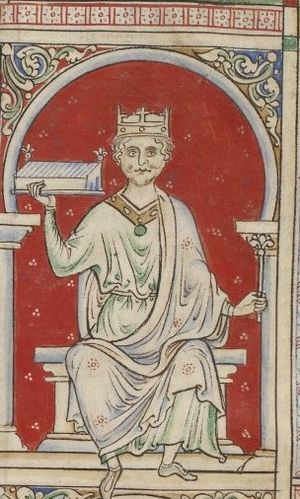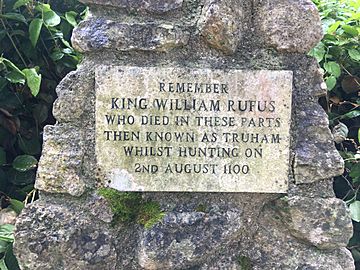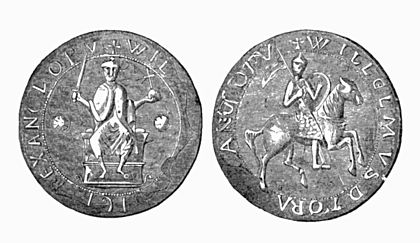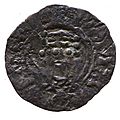William II of England facts for kids
Quick facts for kids William II |
|
|---|---|

Portrait by Matthew Paris
|
|
| King of England (more...) | |
| Reign | 26 September 1087 – 2 August 1100 |
| Coronation | 26 September 1087 |
| Predecessor | William I |
| Successor | Henry I |
| Born | c. 1056 Normandy, Kingdom of France |
| Died | 2 August 1100 (aged approximately 43–44) New Forest, Hampshire, England |
| Burial | Winchester Cathedral |
| House | Normandy |
| Father | William the Conqueror |
| Mother | Matilda of Flanders |
William II (born around 1056 – died 2 August 1100) was the King of England from 1087 until his death. He was also powerful in Normandy and had a lot of influence in Scotland. However, he found it harder to control Wales.
William was the third son of William the Conqueror. People often called him William Rufus. Rufus is a Latin word meaning "the Red." This nickname might have come from his reddish face or, more likely, because he had red hair when he was younger.
Historians say William was a brave soldier and a successful general. He kept England orderly and fair. He also brought Scotland under his rule and gained more land in France.
Contents
Who Was William Rufus?
William's exact birthday is not known, but he was born between 1056 and 1060. He was one of four sons of William the Conqueror and Matilda of Flanders. His older brothers were Robert Curthose and Richard. His younger brother was Henry. Richard died in a hunting accident around 1075.
When his father, William the Conqueror, died in 1087, William became King of England. His older brother Robert inherited Normandy.
William also had several sisters:
- Adela, who married a French count.
- Cecily, who became a nun.
- Agatha, who died young.
- Constance, who married the Duke of Brittany.
Records show that William and his brothers did not always get along. One story says that William and Henry once played a trick on Robert by pouring a chamber pot on him from above! Their father had to step in to stop the fight.
Ruling England and France
Having England and Normandy ruled by two different brothers caused problems for nobles. Many nobles owned land in both places. They worried they might upset one ruler by supporting the other. They thought the best solution was to unite England and Normandy under one king again.
This led to a rebellion in 1088. Nobles tried to replace William with his brother Robert. But Robert did not come to England to lead his supporters. William gained the support of the English people by promising better government. He defeated the rebellion and secured his power.
In 1091, William invaded Normandy. He defeated Robert's forces and made Robert give up some of his lands. The brothers later made peace. William even agreed to help Robert get back lands lost to France. William continued to fight fiercely to protect his lands and interests in France throughout his life.
William Rufus was a strong king in England. His power reached local areas more than in France. He built the original Westminster Hall starting in 1097. This huge building was meant to show his subjects how powerful and grand his rule was.
William and the Church
After his father's advisor, Lanfranc, the Archbishop of Canterbury, died in 1089, William did not appoint a new archbishop for many years. He kept the Church's money for himself during this time.
In 1093, when William became very ill, he finally chose a new archbishop: Anselm. Anselm was a very important religious thinker. However, William and Anselm often disagreed on Church matters. Anselm wanted to make changes to the Church, which William did not like.
Their disagreements led to a long conflict between the King and the Church. Anselm eventually went into exile in 1097. He took his case to the Pope. The Pope, Urban II, was busy with other conflicts. He made an agreement with William. William recognized Urban as the true Pope, and Urban allowed the Church in England to continue as it was. Anselm remained in exile, and William continued to collect money from the Archbishop of Canterbury's lands until he died.
Despite his conflicts with the Church, William helped start Bermondsey Abbey. He gave it land and money.
Wars and Rebellions
William Rufus inherited a well-organized kingdom from his father, thanks to the Domesday Book. This survey helped the king collect taxes. William was strong in dealing with rebellions. In 1095, when a powerful earl named Robert de Mowbray refused to attend the King's court, William led an army against him and won.
William also had success in wars with other countries. In 1091, he stopped an invasion by King Malcolm III of Scotland. He made Malcolm promise loyalty to him. In 1092, William built Carlisle Castle. This helped him take control of lands that Scotland had claimed.
Later, Malcolm invaded England again and was killed in battle in 1093. William supported Malcolm's son, Duncan II, and then another son, Edgar, to become King of Scotland. With William's help, Edgar became king in 1097. Edgar then recognized William's authority over some Scottish lands.
In 1097, William also led two campaigns into Wales. He did not win any major battles, but he built many castles to defend the border.
In 1096, William's brother, Robert Curthose, joined the First Crusade. He needed money for this journey. So, he gave his Duchy of Normandy to William in exchange for a large payment. William raised this money by collecting a special, heavy tax from all of England. While Robert was away, William ruled Normandy. Robert did not return until after William's death.
As ruler of Normandy, William fought in France from 1097 to 1099. He gained control of northern Maine. Some historians believe he was planning to invade another part of France when he died.
The Death of William II

On 2 August 1100, William went hunting in the New Forest. He was killed by an arrow. The exact details of his death are not clear. The earliest record, the Anglo-Saxon Chronicle, simply says he was "shot by an arrow by one of his own men." Later writers named the killer as a nobleman called Walter Tirel.
After William fell, the nobles who were with him left his body. An arrow maker named Eli Parratt later found it. William's younger brother, Henry, quickly rode to Winchester to secure the royal treasury. He then went to London and was crowned king within days.
Many Church writers at the time saw William's death as a punishment from God. They thought it was a fitting end for a king who had argued with the Church. Over the years, people have wondered if William's death was an accident or if he was murdered. Walter Tirel was known as a very good archer, so some found it strange that he would make such a mistake. Also, William's brother Henry was part of the hunting group that day and became king very quickly.
Modern historians still debate what happened. Some believe it was an accident, as hunting was dangerous back then. Others think it was a planned murder, pointing to how quickly Henry acted after William's death.
William's remains are in Winchester Cathedral. They are mixed with other royal bones in special chests.
The Rufus Stone
There is a stone in the New Forest called the "Rufus Stone." It is near the village of Minstead. This stone is said to mark the spot where William II died. This idea became popular in the 1600s.
The story goes that the fatal arrow bounced off a tree before hitting William. King Charles II visited the forest in the 1600s and was shown a tree believed to be the one. This tree was later cut down. The Rufus Stone was put up in the 1700s. It was originally about 5 feet 10 inches tall with a stone ball on top. King George III visited the stone in 1789, and an inscription was added to remember his visit. In 1841, a cast iron cover was put over the stone to protect it from damage.
How People Saw William
William was a skilled soldier, but he was also a tough ruler. It seems many people he governed did not like him. The Anglo-Saxon Chronicle said he was "hated by almost all his people and abhorrent to God."
Many writers of the time were churchmen. Because William had many disagreements with the Church, these writers often wrote negatively about him. His main advisor was Ranulf Flambard, who William made Bishop of Durham. This was a political choice, as the bishopric was also a powerful landholding.
Some people at the time complained that William's royal court was not well-behaved. Like other Norman leaders, William did not seem to value English people or their culture very much.
Images for kids
-
Silver penny of William II showing a crowned head facing forward (1089), Yorkshire Museum, York
-
Memorial stone in the grounds of Beaulieu Abbey, Hampshire
-
Tomb of William Rufus in Winchester Cathedral (Robert Chambers, p.161, 1832)
See also
 In Spanish: Guillermo II de Inglaterra para niños
In Spanish: Guillermo II de Inglaterra para niños










